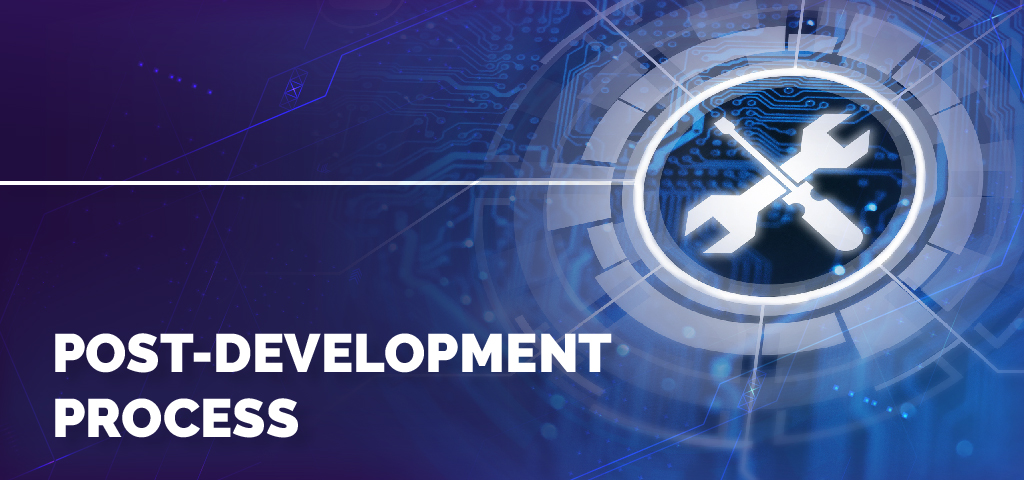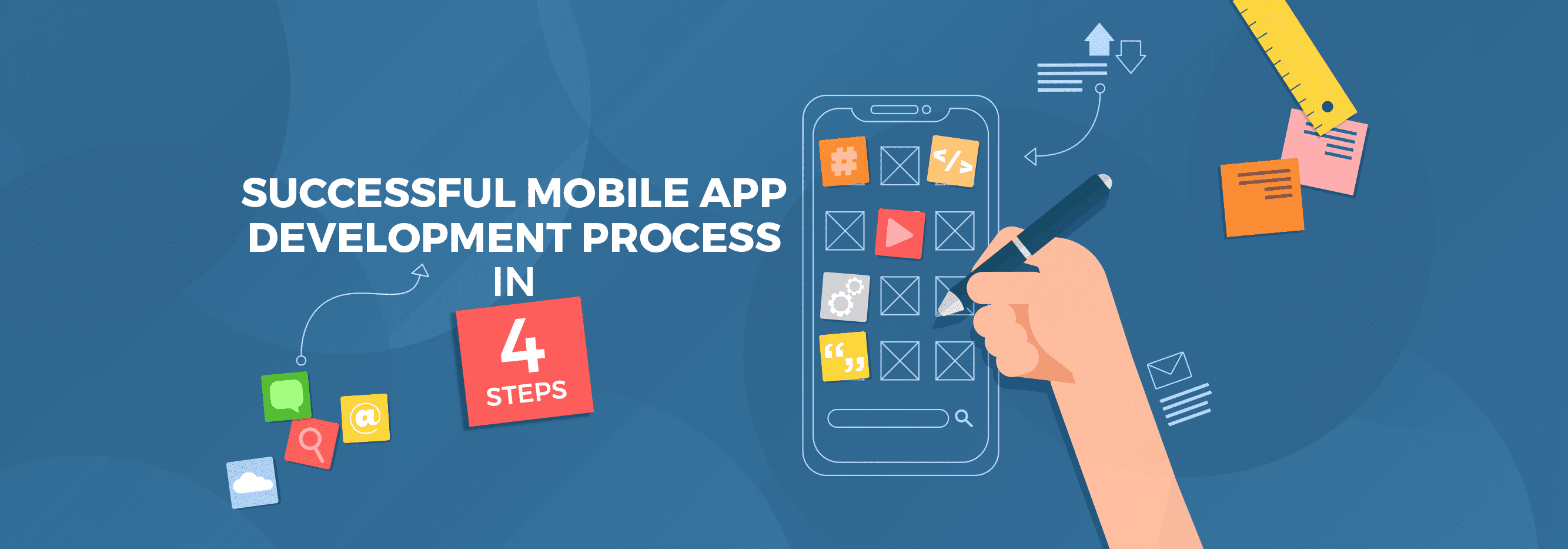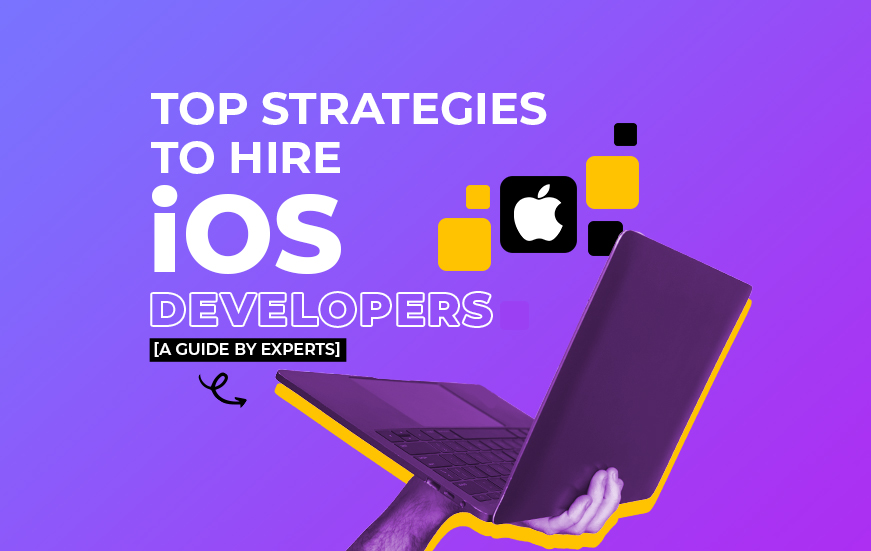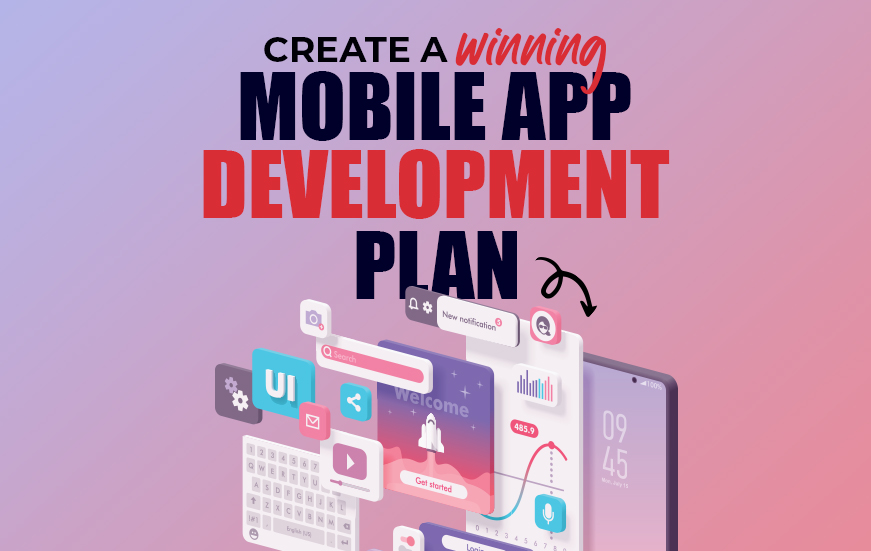Mobile apps aren’t a luxury or an option for businesses anymore, they are a necessity. The need for mobile application development for business owners is increasing at a rapid rate. Mobile apps can increase brand recognition and organic traffic tremendously.
The global mobile app revenue is expected to reach a staggering figure of $935 billion by 2023.

The scope of mobile application development is booming and it’s about time businesses understand how to plan an app with a well-structured iOS and Android app development process.
So without further ado, let’s discuss the 4 phases of mobile application workflow and development step by step.
Table of Contents
Toggle1.Pre-Development Process:

A dysfunction, unappealing or unsatisfactory app leaves a bad impression for your end-users, making them hesitant towards using your app again. That’s why it is imperative for you to optimally utilise your time and build a successful app on your first try.
The first and foremost step towards a successful mobile app development process is a carefully structured plan with thorough analysis and a pre-defined strategy. A plan of action provides a well-guided path for your mobile app design and development, making it easier to spot mistakes, anticipate problems and deliver an unforgettable experience for your audience.
This initial stage is frequently overlooked or dealt with in a hurry-scurry manner, leading to a defective and inadequate mobile app development process. After all, haste makes waste.
Setting goals, defining concepts, gaining insights through research and defining the target audience are equally significant steps in an ideal mobile app development process. Additionally, a pre-development plan provides you with an accurate budget estimation and lets you plan marketing strategies in advance.
Strategy and Analysis:
The detailed analysis leads to an effective strategy for your mobile app project plan. Objectives for developing mobile apps differ from business to business depending on the requirements and collected data.
You need to find the answer to as many questions as possible to create a streamlined process in building an application.
The following points will help you in building productive mobile app development process steps by utilising market research optimally:
- App Objective: Defining an objective for the mobile app is easier than you think. You need to inspect your brand or business to answer the following questions- Does your brand need a mobile application? What solutions will mobile applications provide for your business? Can your business plan incorporate a mobile app? Does your yearly budget have enough resources to start a mobile app development process? How to plan an app? how to start mobile applications development?
- Target Audience: Without a defined target audience, you don’t even know who you’re making the app for. Carefully analyse the latest market trends, demographics and potential users to target a specific segment of the audience.
- App Functionalities: After defining the objective and target audience, you can easily conduct further research to answer questions like- What are the key features of your mobile app? How does your app help your end-users? How will your mobile app increase customer engagement?
- Competitor Analysis: Delve deeper into market research to find out more about your competitors and similar apps in the market. Analyse your competition to make a mobile app that is unique and provides a better overall user experience.
- Investment Research: After forming a rough strategy using the aforementioned steps, you need to form an approximate estimation of your app budget finances. This makes it easier and more comfortable for you to move forward with your mobile phone app development process.
- Planned Marketing: This stage is a pre-development plan for the post-development stage. Without a marketing or promotional plan for your brand’s mobile app, the number of downloads, customer traffic and engagement will remain stagnant with low numbers. Use the data gained through market research to decide the best possible formats, mediums and platforms for your app marketing.
UI/UX design:
The main purpose of the mobile app’s user interface is to provide a seamless and unforgettable user experience to the audience.
Even with the best functionalities, your app may fail to achieve the desired results if your audience finds it difficult to use. Delivering user-friendly, engaging and intuitive user experiences is what makes your app shine among the ever-increasing competition in the digital era.
Simplify the method of mobile app design and development by segregating the process-
- Define and ideate as many features and solutions as possible for your app;
- Shortlist the best design features and ideas;
- Develop a design mockup or prototype with the selected design features;
- Modify and finalise the app design for further development.
The following mobile app design stages will help you design impeccable UI/UX to achieve all your app development goals.
- App Architecture: You need to decide the structure of the app and how it deals with collected information and data. The workflow of the app determines its efficiency to manage user information, user interactions, in-built data and more. This stage of mobile app design and development should be carefully planned as it shapes the display of your app.
- Style Sheet: The style and design of your mobile app should mirror the style, colour and fonts of your brand. First of all, it promotes your brand and directly improves brand recognition. Secondly, it provides a smooth and consistent feel to your app’s user interface.
- Wireframes and Mockups: Wireframes are digital sketches to conceptualise the app’s layout and visual structure. And Mockups takes it a step further by adding the style sheet, workflow and data structure to the wireframe of the mobile app. Before building a prototype, wireframes and mockups are created to finalise the display of the mobile app.
- Prototype: Mockups are enough to understand and finalise the look and layout, but a prototype tests the functionalities of your planned mobile app. This is the last of your UI/UX mobile app design stages. Wireframes and mockups are digital sketches, hence un-clickable. Prototypes can be used to simulate the user experience and the design flow of the mobile application, providing a realistic visualization to finalise or modify the design before development.
A detailed market research/analysis with a pre-planned strategy and an impeccable design structure for your mobile app gets you ready to dive into the development process.
2.Development Process:

After completing the research, plan and design of your app, you enter the second phase of the app development process. The actual programming of the mobile app begins at this stage. There are many frameworks, programming languages and technology stacks for app development, and you need to choose the right technologies to achieve maximum efficiency in the backend, API, and frontend operations.
Backend/Server-side Operations:
The Back-end or server-side of the mobile application is responsible for securing, storing and processing the data. And to keep your app running without a hitch, you need to choose the right technology for serving this purpose optimally.
Without efficient backend development, your mobile app delivers unstable and dysfunctional performance. It is the backbone of mobile app development, and hence you must select the most suitable programming language or technology stack according to your developer team’s proficiency.
Here’s a list of the most favoured mobile app development tools and libraries for the backend:
- PHP
- Ruby on Rails
- NodeJS
- AngularJS
- ReactJS
- .NET
- GOLang
Application Program Interface:
Application Program Interface or API determines the interactivity of the software components in the mobile app. Along with effortless accessibility and sharing of the app’s data, API lets the app access the data of other apps as well, making it an indispensable mobile app tool.
For example, the Uber app uses an effective API that allows you to access driver information, messaging and GPS through different sources. The API significantly increases the flexibility, compatibility and efficiency of your mobile app.
Frontend/Client-side Operations:
The front end or client side of the mobile app is the interface that your end-users use and interact with. You can effortlessly captivate your audience and retain customers by delivering a seamless user experience through your mobile app front end.
There are different methods of front-end development for mobile apps:
Native Development: This is a platform-specific iOS and Android software development process. It requires different teams or a large team of developers for developing separate codebases for iOS and Android. Although this is a comparatively more expensive and time-consuming way of frontend development, it provides 100% output, quick loading speed and impeccable functionality to your mobile app for the specific platform.
iOS mobile app development tools:
- Objective-C
- Swift
- Xcode
Android mobile app development tools:
- Java
- Kotlin
- Android Studio
Cross-Platform Development: Various full-fledged frameworks are used to build cross-platform mobile apps with a single codebase. With a “write once, use everywhere” principle, this method of iOS and Android app development process simplifies the development process by eliminating a huge portion of the developers’ time and effort.
Cross-platform mobile app development tools:
- Flutter
- React Native
- Cordova
- Ionic
- Xamarin
- PhoneGap
Click here to get an in-depth understanding of Flutter VS Native technologies.
Hybrid Development: This method of frontend mobile app development integrates the elements of a web app in native app development. With enhanced performance and high scalability, this method of Android and iOS app development process provides fast-paced development and easy maintenance.
This is a web application built with a shell of a native app.
The languages used to build web applications are also used to create Hybrid apps:
- HTML5
- CSS
- JavaScript
3. Testing:

App testing enhances your mobile app development process steps up and takes it up a notch. Quality assurance (QA) with thorough testing is the best way to ensure optimal stability, usability, and security of the mobile app. A quality assurance team can run different types of tests to check the outcomes and ability to produce the requirements and expectations targeted in the pre-development stage.
Without a comprehensive quality assurance test, you may end up deploying an unsatisfactory and defective mobile app. Modifications or new features are added in this stage to finalize the mobile app for deployment.
User Experience Testing
User experience testing is done to evaluate the app design for ensuring a seamless user interface. The final interface should mirror the finalized app design prototype created in the pre-development stage.
This test makes sure that your audience gets an unforgettable experience while using your mobile app with the finalized color scheme, style sheet, data architecture, navigation, icons, buttons, and more.
Functional Testing
Functional testing lets you evaluate different functions of your mobile app. The app must work efficiently while being used by multiple users at the same time.
The functionality of every app must be tested meticulously to make sure that the app works optimally after it is launched. For catching bugs and errors, the mobile app is tested under different conditions. It can be tested as a whole and individual feature-based. Functionality tests accentuate many unexpected mistakes and defects that can be solved or fixed to provide impeccable features and functions for your end users.
Performance Testing
A simulation of usage spikes with multiple concurrent end-users allows you to test the performance of a mobile app. App loading speed, app size, response to changes from client-side, optimization to consume less phone battery, and improve network bandwidth are tested to ensure top-notch performance.
Security Testing
Security is the most concerning part of developing mobile apps. Security tests eliminate the risk of viruses and hackers while safeguarding sensitive data and customer databases.
The significance of security testing doubles if you have payment portals in your mobile app. Your quality assurance team can check vulnerabilities and predict potential breaches to fix them and deliver air-tight security features in the app-building process.
From secured log-in details to preventing data leakage, everything is taken care of in this stage of testing.
Certification Testing
Every mobile app project plan needs to be in accordance with the licensing agreements, industry standards, terms of use, and other requirements of mobile app platforms like Google’s Play Store and Apple’s App Store. That’s certification testing is done to ensure hassle-free app deployment.
4. Post-Development Process:

After completing all of the mobile app development stages effectively, it is time to launch your app. App deployment and post-launch maintenance are equally significant parts of the iOS and Android app development process.
Deployment
You need a developer account with app platforms like Google Play Store for Android apps and Apple App Store for iOS apps to release or launch a native mobile app.
The following information/data is required for submitting the mobile app:
- App title
- App description
- Keywords
- Type/category
- Icon/thumbnail
- App Screenshots
iOS apps require a review or screening process to check if the mobile app complies with the rules and regulations of the Apple App Store.
On the other hand, Google Play Store lets you launch your Android app without any review process, allowing your app to be available for downloading within some hours.
Maintenance and Support
After your app is ready for download, you need to track the important metrics for measuring your mobile app’s overall performance, interaction, and success.
Pay attention to suggestions, comments, ratings, and feedback to solve problems and provide continuous improvements.
Stay up-to-date with the latest technological trends and advancements to provide new patches and updates according to the market’s needs and requirements.
Marketing the mobile app is another significant part of the post-launch app-building process. Create advertisement posts or videos to highlight the key features and use cases of the mobile app to attract the targeted audience. You can use social media to increase the reach of your app for boosting traffic on your mobile app.
Wrapping up:
Mobile apps are bringing the world to our fingertips. With the ever-increasing demand for mobile apps, businesses are looking for optimal ways to satisfy their app development needs.
The pre-development process, development process, testing, and post-development process are the 4 phases of the mobile applications workflow.
Forming a strategy using market analysis, choosing the right technologies for programming and development, and testing the app for removing bugs and maintaining stability are the steps that you should follow before launching or submitting a mobile app.
If you require assistance regarding mobile app development, we are here to help!
Here at Communication Crafts, we leverage the latest and most suitable technologies to deliver cost-effective and impeccable mobile app solutions that provide a seamless and captivating user experience.
Looking for visually appealing and high-functioning mobile apps?
We’ve got you covered
 Blog Communication Crafts
Blog Communication Crafts





